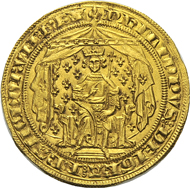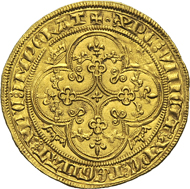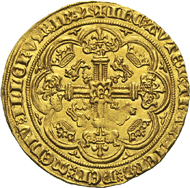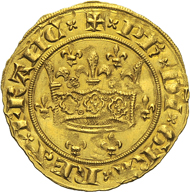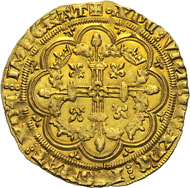The very moment, when Jacques de Molay, Grand Master of the Knights Templar curses Philip King of France while burning at the stake, belongs to the most impressive myths of our world’s history. You see, only such a curse explained to the people of the fourteenth century why Philip’s sons died so fast one after the other: the eldest son took the fever after having reigned for two years. His newborn heir lived only four days, then Philip’s second son took over. But he, too, aged 28 wasted away of dysentery, four years later. Charles IV, the last of the brothers, reigned 6 years, then he died of an illness as well. And after his death, in 1328, there were no more French Capetians. Now, the question was: Who was to reign over France?
Philipp VI, 1328-1350. Pavillon d’or, no year (June 8, 1339). Duplessy 251. Extremely fine. From the Dr Edoardo Curti Collection, upcoming Künker auction (March 2013), No. 2443. Estimate: 10,000 euros.
Le Roi trouvé, ‘the king found’ the French themselves gave this Philip VI who acceded his reign on April 1, 1328 this nickname. Actually his predecessor had had a child, a daughter, however she could not follow her father since the Salic law was applied in France prohibiting women to inherit a throne. Philip of Valois was popular, he came from a distinguished family and, initially, received much devotion. He succeeded even in convincing his keenest rival for the crown: Edward III, king of England and duke of Aquitaine was in straight succession a grand child of Philip IV of France, however by Philip’s daughter. He went personally to Paris and paid homage for his French holdings.
Edward III, 1327-1377. Noble no year (1356-1361), London. Seaby 1490. Extremely fine. From the Dr Edoardo Curti Collection, upcoming Künker sale (March 2013), No. 2418. Estimate: 7,500 euros.
At this time Edward III was king already, but he was completely under the control of his mother Isabella, the daughter of Philip the Fair, and her lover, Roger Mortimer. Together this couple had deposed Edward’s father, the true king of England, and then executed. Only on October 19, 1330 the young ruler succeeded in getting rid of both of them.
‘Il piccolo re d’Inghilterra’ – ‘the little king of England’ Edward III was called by an Italian chronicler. Then, however, nobody imagined that this man was to become a meaningful man in history. In particular because it seemed that he had enough to do in his own country. The Scots were bothering him. And since Scotland had always been a traditional ally of France, this was an excellent reason for plundering extensively Edward’s belongings. Many French aristocrats made divine profit. In 1337 Philip VI even seized Aquitaine. This duchy had been under the control of the Plantagenets since Eleonore married Henry II in 1152. That was a truly incredible insult!
Eventually, Edward had to act, naturally with a campaign. The money, though, was lacking and for that reason he had to rely on his vassals’ financial and military support. Those, on their turn, owed him support only in waging a just war. This necessity drove Edward to his argumentation that he himself had a much better claim on the French throne than Philip. And indeed, with this move he won the support of Italian bankers, of his vassals, and he even won over the aristocrats in Normandy and Brittany traditionally well disposed to England.
The merchants in Flanders liked the English king, too. At least they sourced the wool used for weaving their famous cloths from the island kingdom. Flanders was a French fief, though. And the Flemings declared ready to support the king only when he would declare himself king of France. On January 26, 1340 Edward III did what they wanted.
Philip VI, 1328-1350. Couronne d’or no year (February to April 1340). Of the utmost rarity. Extremely fine to FDC. From the Dr Edoardo Curti Collection, upcoming Künker sale (March 2013), No. 2444. Estimate: 35,000 euros.
We are informed about the French reaction by an extremely rare issue of Philip VI which was probably struck during the first three months following Edward’s assumption of the title king of France. It is a magnificent gold coin whose obverse is completely filled up with a crown embellished with lilies. Around the crown we see six lilies which, since the high Middle Ages, were considered to be symbols of the divine grace the French kings enjoyed. Philip, by the Grace of God King of France, reads the legend on the obverse.
While the reverse is quite similar to the ‘common’ issues of Philip, the obverse presents an uncommonly simple image. It corroborates the claim of the Valois on being the only true ruler of France, crowned in Reims, anointed with the holy oil.
And being a gold coin it demonstrated the French king’s wealth that was simply incomparable to Philip’s financial limits which, indeed, forced him to finance his wars through credits. The Florentine banking company Bardi lent Philip between 600,000 and 900,000 florins, and another family, the Peruzzi, further 400,000 to 600,000. They lost everything. The first campaign against France not only ruined Edward but also both banking houses.
Bankrupt after the first campaign! No contemporary would have imagined that this miscarried beginning was leading to a conflict that wrote history under the name of Hundred Years’ War and that did not end before 1453. The English kings, by the way, dropped their last claims on the French throne only in 1820.
This is the link to the latest Künker sale.



